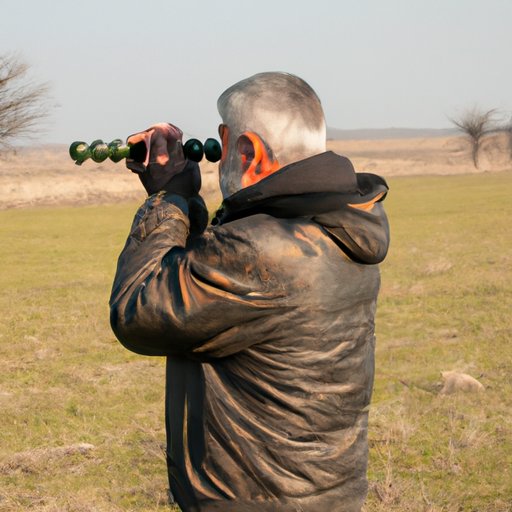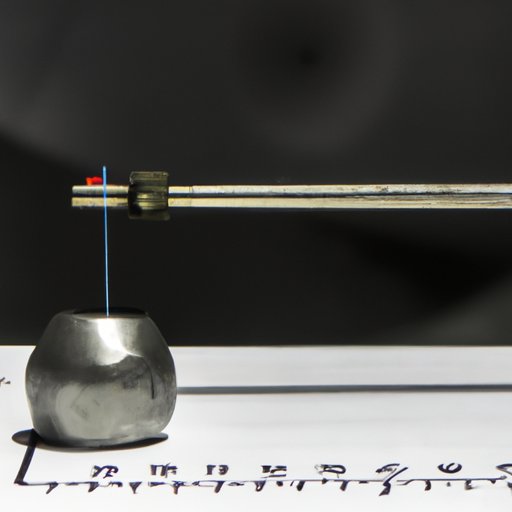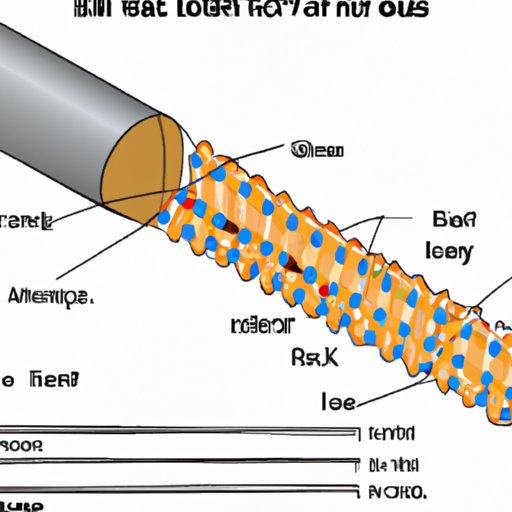Introduction
The distance a bullet can travel horizontally is an important factor for both recreational and professional shooters alike. Knowing the maximum range of a bullet fired horizontally can help gun owners understand the capabilities of their firearms, while providing tactical advantages when engaging in hunting or target shooting. In this article, we will explore the physics of how far a bullet can travel horizontally, examining the forces that act on a bullet in flight, the effects of gravity and air resistance, and the maximum range of different types of bullets.
Exploring the Physics of How Far a Bullet Can Travel Horizontally
The physics of a bullet’s trajectory is complex and depends on a number of factors, including the initial speed, weight, and shape of the bullet, as well as the air resistance and gravitational force acting on it in flight. To better understand how far a bullet can travel horizontally, let’s take a look at each of these factors in detail.
Examining the Forces Acting on a Bullet in Flight
When a bullet is fired from a gun, it is propelled forward by the force of the expanding gas created by the burning gunpowder in the cartridge. This force is known as the muzzle velocity and is measured in feet per second (fps). The greater the muzzle velocity, the faster the bullet will travel and the farther it will go. However, once the bullet leaves the barrel of the gun, it is no longer being propelled forward by the force of the expanding gas and instead is affected by the forces of gravity and air resistance.
Investigating the Effects of Gravity on Bullet Trajectories
Gravity is a constant force that affects all objects on Earth, including bullets. As a bullet travels through the air, the force of gravity pulls it downward, resulting in a curved trajectory known as a parabola. The more powerful the firearm, the higher the muzzle velocity, and the flatter the trajectory of the bullet. This means that the bullet will travel farther before it begins to drop due to the force of gravity.
Analyzing the Influence of Air Resistance on a Bullet’s Range
Air resistance, or drag, is another factor that affects the trajectory of a bullet. As a bullet moves through the air, it encounters air molecules that resist its movement, slowing it down and causing it to drop more quickly than it would if there were no air resistance. The amount of air resistance a bullet experiences depends on its shape and size, with larger and heavier bullets experiencing greater air resistance than smaller and lighter bullets.

Examining the Distance Capabilities of Bullets Fired Horizontally
Now that we have examined the physics of how far a bullet can travel horizontally, let’s take a look at the actual distances that different types of bullets are capable of traveling when fired horizontally. We will also compare the maximum range of a bullet fired horizontally with other types of ammunition.
Investigating the Horizontal Distance Capabilities of Different Types of Bullets
The type of bullet used has a significant effect on the maximum range of a bullet fired horizontally. Rifle bullets typically travel the farthest, with some able to reach distances of up to 2,000 yards. Pistol bullets usually travel shorter distances, with the longest ranges reaching around 1,000 yards. Shotgun pellets, on the other hand, have relatively short ranges, with most only traveling a few hundred yards.
Comparing the Maximum Range of a Bullet Fired Horizontally with Other Ammunition
It is also important to note that the maximum range of a bullet fired horizontally is significantly greater than that of other types of ammunition. For example, arrows typically only travel up to 600 yards, whereas grenades and mortars have maximum ranges of around 4,500 yards. This demonstrates the impressive distance capabilities of bullets fired horizontally.
Testing the Limits: How Far Can a Bullet Go?
In order to accurately measure the maximum range of a bullet fired horizontally, it is necessary to test the bullet under controlled conditions. There are several techniques used to do this, including firing the bullet into an open field or into a large body of water. Let’s take a look at these testing methods in more detail.
Discussing the Techniques Used to Test the Maximum Distance of a Bullet
One of the most common testing methods used to measure the maximum range of a bullet fired horizontally is to fire the bullet into an open field. This method allows testers to accurately measure the distance the bullet travels before it hits the ground, giving them an accurate measure of the bullet’s maximum range. Another testing method is to fire the bullet into a large body of water, such as a lake or an ocean. This method allows testers to measure the bullet’s maximum range without having to worry about the bullet hitting any unintended targets.
Examining the Testing Methods Used to Measure the Horizontal Range of a Bullet
In addition to these two testing methods, there are also more sophisticated testing techniques used to measure the horizontal range of a bullet. These techniques involve using high-speed cameras and computers to track the bullet’s trajectory in real time. This allows testers to accurately measure the bullet’s maximum range and determine the exact angle at which the bullet must be fired in order to reach its maximum range.
What Factors Determine the Distance a Bullet Travels Horizontally?
In addition to the testing methods mentioned above, there are a number of other factors that can affect the maximum range of a bullet fired horizontally. Let’s take a look at some of these factors in more detail.
Investigating the Effect of Gun Barrel Length on Bullet Trajectory
The length of the gun barrel can have a significant effect on the maximum range of a bullet fired horizontally. Longer barrels allow the bullet to accelerate for a longer period of time before it exits the barrel, allowing it to reach higher velocities and thus travel farther. Shorter barrels, on the other hand, reduce the bullet’s acceleration time and thus reduce its maximum range.
Examining the Impact of Muzzle Velocity on a Bullet’s Range
The muzzle velocity of the bullet is also an important factor in determining its maximum range. The higher the muzzle velocity, the faster the bullet will travel and the farther it will go before it begins to drop due to the force of gravity. Thus, bullets with higher muzzle velocities are capable of traveling greater distances than those with lower muzzle velocities.
Analyzing the Effect of Bullet Weight and Shape on Bullet Trajectory
The weight and shape of a bullet can also have an effect on its maximum range. Heavier bullets tend to experience more air resistance, causing them to drop more quickly than lighter bullets. Likewise, bullets with flat noses tend to experience less air resistance than those with pointed noses, allowing them to travel farther before they begin to drop.

Investigating the Maximum Range of a Bullet Fired Horizontally
Now that we have discussed the factors that affect the maximum range of a bullet fired horizontally, let’s take a look at what conditions are necessary for a bullet to reach its maximum range. We will also examine the environmental factors that can affect a bullet’s range.
Examining the Conditions Necessary for a Bullet to Reach Its Maximum Range
In order for a bullet to reach its maximum range, it must be fired at the correct angle and with the appropriate muzzle velocity. If the angle is too steep or the muzzle velocity is too low, the bullet will not reach its maximum range. Additionally, the weather conditions must also be taken into account, as wind and humidity can have a significant effect on a bullet’s trajectory.
Discussing the Environmental Factors That Can Affect a Bullet’s Range
Wind, humidity, and temperature all have an effect on a bullet’s trajectory. Wind will cause the bullet to drift off course, while humidity can slow the bullet down and cause it to drop more quickly than it otherwise would. Temperature can also affect the speed and trajectory of a bullet, with hotter temperatures resulting in a slower bullet and a steeper trajectory.
Ballistic Analysis: Measuring the Horizontal Distance of a Bullet
In addition to the testing methods discussed above, there are also mathematical formulas and tools used to measure the horizontal range of a bullet. These tools use complex equations to calculate the bullet’s trajectory in real time, allowing testers to measure the bullet’s maximum range with precision. Let’s take a look at some of these tools in more detail.
Exploring the Mathematical Formulas Used to Determine Bullet Trajectory
The most commonly used mathematical formula for determining bullet trajectories is the ballistic coefficient equation, which takes into account the bullet’s mass, diameter, and muzzle velocity. This equation is used to calculate the bullet’s trajectory and the maximum range it is capable of reaching.
Examining the Tools Used to Measure the Horizontal Range of a Bullet
In addition to the ballistic coefficient equation, there are also a number of tools used to measure the horizontal range of a bullet. These tools use laser rangefinders, high-speed cameras, and computer programs to track the bullet’s trajectory in real time, allowing testers to accurately measure the bullet’s maximum range.

Comparing the Horizontal Flight Paths of Different Types of Bullets
Finally, it is important to note that the horizontal flight paths of different types of bullets vary significantly. Rifle bullets typically travel the farthest, with some able to reach distances of up to 2,000 yards. Pistol bullets usually travel shorter distances, with the longest ranges reaching around 1,000 yards. Shotgun pellets, on the other hand, have relatively short ranges, with most only traveling a few hundred yards.
Conclusion
In conclusion, this article explored how far a bullet can travel horizontally. We examined the forces acting on a bullet in flight, the effects of gravity and air resistance, and the maximum range of different types of bullets. We also discussed the techniques and tools used to measure the horizontal range of a bullet. Finally, we investigated the factors that determine the distance a bullet travels horizontally, including gun barrel length, muzzle velocity, and bullet weight and shape. By understanding the physics of how far a bullet can travel horizontally, gun owners can make more informed decisions when engaging in shooting activities.
(Note: Is this article not meeting your expectations? Do you have knowledge or insights to share? Unlock new opportunities and expand your reach by joining our authors team. Click Registration to join us and share your expertise with our readers.)
